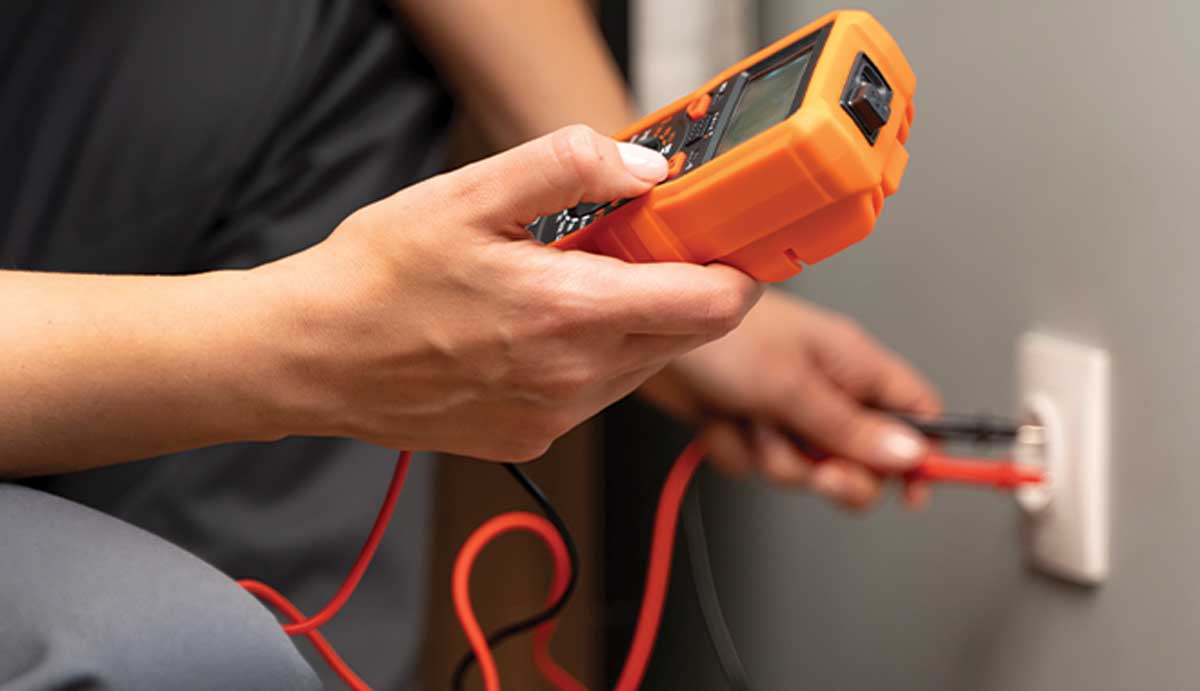Things to Check Before Calling an Electrician
Before calling an electrician, check your outlets and switches for any discoloration, scorch marks, or strange smells. Listen for buzzing sounds coming from them.
Use a multimeter to test your appliances and devices, and look at the cords for any damage. Make sure the bulbs in your light fixtures are secure and check for any frayed wires.
Look at your circuit breaker to see if any switches are tripped, worn out, or have scorch marks. Test your GFCI outlets using their test buttons.
Notice if your walls feel warm or if there are unusual smells, as these can be signs of electrical problems. Keep an eye on your electrical system to ensure the load is balanced.
If you see sparks, if breakers trip often, or if there is visible damage, write down the details to tell the electrician.

Inspect Outlets and Switches
Before calling an electrician, check all outlets and switches for any wear, damage, or problems. Start by looking at each outlet and light switch in your home. See if there is any discoloration on switch plates, scorch marks, or strange smells coming from them. These could mean overheating or bad wiring.
Touch each outlet and electrical switch. If any feel warm or hot, this could be a serious safety risk, pointing to possible electrical problems. Listen for buzzing or crackling sounds when you use switches or plug-in devices. These sounds usually mean loose connections or worn-out parts.
Make sure all screws holding the cover plates are tight. Loose plates can expose the wiring and cause safety hazards. If an outlet or switch isn’t working right, like flickering lights or power cutting in and out, fix these issues quickly.
Test Appliances and Devices
Once you know the outlets and switches are working right, it is time to test your appliances and devices for any problems.
First, unplug each appliance and electrical device. Look at the plug and cord to see if there is any visible damage like fraying or exposed wires. These can be safety hazards.
Plug the appliance back in and see how it works. Listen for strange sounds or watch for odd behaviors like flickering lights or inconsistent power. These signs might mean there are electrical problems inside the device.
You can use a multimeter to check the voltage going to the appliance. This helps you find out if the problem is with the device or the outlet.
Think about power surges too. Appliances and devices can get damaged by sudden spikes in electricity. If you have a lot of power surges, it might be smart to get surge protectors or call a professional to check your home’s electrical system.
Examine Light Fixtures
When you check light fixtures, first turn off the power at the circuit breaker to avoid electrical shock. Look at each light fixture for signs of wear or damage. A common problem is a loose bulb, which can cause flickering or lights going on and off. Make sure each light bulb is screwed in tight enough, but don’t overtighten it, as this can damage the fixture.
Then, check the wiring of the light fixtures. Look for frayed or exposed wires. This could mean a wiring problem that needs a professional electrician. If you see any issues, don’t try to fix them yourself. Write down what you see and tell your electrician.
For light fixtures with dimmer switches, make sure the bulbs work with the dimmer. If they don’t, the lights might flicker or make buzzing sounds. Also, check if the dimmer switch works right. If the switch feels hot or doesn’t work properly, it could cause an electrical problem.
Check Circuit Breaker
To make sure the electrical system works right, start by looking at the circuit breaker panel. This panel is usually in the basement, garage, or utility room. Before opening it, make sure your hands are dry and you are standing on a dry surface to avoid electric shock.
Once the panel is open, look at each circuit breaker. See if any are in the ‘off’ position or look like they are halfway between ‘on’ and ‘off.’ This means the breaker has tripped. Breakers trip to protect the system from overloads, short circuits, or ground faults.
To reset a tripped breaker, flip it to ‘off,’ and then to ‘on.’ If it trips again right away, there is a bigger problem that needs an electrician.
Also, check for signs of wear, like scorch marks, frayed wires, or rust. These can mean there are more serious electrical problems. Write down anything unusual and tell the electrician. This can help them fix the problem faster and keep the electrical system safe and reliable.
Check Your GFCI Outlets
Making sure your Ground Fault Circuit Interrupter (GFCI) outlets work is important for safety in wet areas like kitchens and bathrooms. These outlets can stop electric shocks by cutting off power if there is a problem.
To check your GFCI outlets, find them in places like kitchens, bathrooms, garages, and outside. Each GFCI outlet has a test button and a reset button. Press the test button to see if the outlet trips and cuts off the power. If it works, press the reset button to turn the power back on. If the outlet does not trip or reset, it might be broken, and you should call an electrician.
Look at your GFCI outlets regularly to see if they are damaged or worn out. Working GFCI outlets are important for keeping your home safe from electrical hazards. They are a key part of a good electrical safety plan.
Troubleshoot Power Outages
Finding out why the power is out needs a step-by-step approach. Start by looking at the circuit breaker box. If a breaker is off, turn it off and then on again. If it trips right away, it could mean too many things are plugged in or there’s a short circuit.
Next, check for blown fuses, especially in older homes with fuse boxes. Replace any blown fuses with ones that have the same amperage to stay safe. Make sure the new fuses match the old ones to avoid problems.
Too many devices on one circuit can also cause power outages. Look at how many things are plugged in. Spread them out on different circuits to stop this from happening.
Also, check outlets and switches for damage or wear. These can cause electrical problems too.
If these steps don’t fix the problem, call a licensed electrician. Knowing these basic steps can help you find the problem and explain it to a professional, making it easier to fix.
Assess Warm Outlets
Finding out why outlets are warm is important because it can mean there are electrical problems that need fixing right away. Warm outlets can be a fire hazard and put both your home and safety at risk. The most common reason is a loose connection, leading to poor electrical contact and too much heat.
To check warm outlets, unplug everything from the outlet. This makes sure the warmth isn’t from high-power devices, which can sometimes make outlets warm. If the outlet is still warm after unplugging, it might mean there’s a bigger electrical problem that needs a professional.
Look at the outlet cover and the wall around it for any signs of discoloration or warping. These signs mean the outlet is overheating and needs fixing right away.
You can also use an infrared thermometer to check the outlet’s temperature. This gives you exact numbers to help figure out what’s wrong.
Look for Singed Wires
Checking for singed wires is crucial because damaged wires can cause serious electrical problems and even fires. Singed wires often indicate bigger issues and need immediate attention. Finding these problems early can prevent fires and keep your home or workplace safe.
- Look: Check for discoloration or burn marks on the wire insulation. Signs of melting or charring mean overheating.
- Smell: A burnt smell near outlets or panels can mean singed wires. This smell comes from the insulation breaking down.
- Touch: Carefully feel the wires. If they are warm or hot, there may be electrical problems.
- Watch: Notice how your electrical devices work. Frequent short circuits or tripped breakers may point to wiring issues.
Check for Flickering Lights
Flickering lights can be a sign of electrical problems that need quick attention. This issue is more than just annoying; it could mean something serious is wrong with your home’s electrical system.
One reason for flickering lights is faulty outlets. This happens when connections are loose or corroded, which can make the electricity flow unevenly, causing the lights to flicker. Check all outlets and switches for any signs of wear or damage as they might be causing the problem.
Another cause could be an overloaded electrical circuit. When too many devices use power from one circuit, it can cause voltage changes, making the lights flicker. Finding out if this happens in just one area or all over the house can help you figure out the problem.
Also, think about the age and condition of your wiring. Older homes with old wiring are more likely to have flickering lights because the insulation and connections can wear out over time. Making sure your home’s wiring meets current safety standards is key to avoiding dangers.
If you still have problems after checking these things, call a professional electrician.
Feel for Warm Walls
Feeling the walls for unusual warmth can help find electrical problems that might be dangerous. Warm walls can mean there are issues with the wires behind them. If not fixed, these problems could cause electrical fires.
- Find the Warm Spot: Locate the exact part of the wall that feels warm. This helps you figure out where the problem might be in the wiring.
- Check Outlets and Switches: Look at the electrical outlets and switches near the warm area. If they feel warm too, it could mean the circuits are overloaded or the wiring is bad.
- Measure the Warmth: Use your hand to see how far the warmth goes along the wall. If it is spread out, the problem might be bigger and need a professional to check it.
- Call an Electrician: If you find any warm walls, call a licensed electrician right away. Electrical issues can be very dangerous, and a professional can inspect and fix the problem.
Unplug and Replug Devices
Unplugging and plugging back in devices can help fix simple electrical problems. This can show if the issue is with the devices or the power supply. Sometimes, devices have small glitches that stop electricity from flowing properly.
First, unplug each device from the outlet. Look at the plugs and cords for any damage, like fraying or exposed wires. If everything looks fine, plug the devices back in securely. This can reset some devices and fix small problems.
If the devices still don’t work, the issue might be with the electrical circuit. In that case, you should call a professional electrician. Doing this check first can give the electrician helpful information, making it quicker to find and fix the problem.
Inspect Power Strips
Inspecting power strips is crucial for keeping your home or office safe from electrical hazards. Power strips help connect multiple devices to a single outlet, so it is important to check them regularly.
- Physical Condition: Look at the power strip and its cords. Check for frayed wires, cracks, or burn marks. If you see any damage, replace the power strip right away to prevent fires.
- Load Capacity: Know the power strip’s load limit. Make sure the total wattage of all plugged-in devices is below this limit. Overloading can cause overheating and fires.
- Surge Protection: If the power strip has surge protection, check if the indicator light works. If the light is off, the surge protection might be broken. Replace the strip if this happens.
- Proper Usage: Use the power strip correctly. Do not connect multiple power strips (daisy-chaining). Avoid plugging in high-power devices that the strip can’t handle.
Listen for Buzzing Sounds
Check for buzzing sounds from electrical outlets or devices. These sounds can show problems in your electrical system that need quick fixing.
Buzzing often means there is damage to your home’s electrical parts. This noise can come from bad wiring or a broken breaker panel, which can be dangerous.
If you hear buzzing, find where it’s coming from. Outlets that buzz may have loose connections or damaged wires, which can cause short circuits or fires. Buzzing from light fixtures or other devices can mean poor wiring or too much power being used.
Also, check the breaker panel. A buzzing sound here may mean a circuit breaker is overloaded or failing.
Good electrical systems should be silent. Any noise means something is wrong and needs a professional to check it.
Smell for Burning Odors
Detecting burning smells is important for spotting electrical problems in your home. This smell can mean serious issues that need quick action to keep your house safe. Catching these warning signs early helps prevent damage and ensures you get the help you need in time.
Monitor Electric Bill
Checking your electric bill often can help you spot unusual jumps in energy use, which might mean there are electrical problems. Keeping an eye on your usage helps you find out where and when issues might start. Sometimes, a sudden increase in your bill can be due to faulty wiring or broken electrical devices. These issues waste energy and increase costs.
When you look at your bill, pay attention to any big changes in how much electricity you use. If your usage goes up a lot without a change in your daily activities, it might be a sign of an electrical problem that needs fixing. You might need to update parts of your electrical system, like replacing old or overloaded circuits, to keep everything working safely and efficiently.
Knowing which appliances use the most power can help you decide if you need upgrades or repairs. By fixing these problems early, you can keep your electricity supply steady and avoid bigger, more expensive issues later on.
Check Fuse Box
The fuse box is a key part of your home’s electrical system. Knowing its condition can help prevent electrical shock and costly repairs.
First, make sure the area around the fuse box is dry and not cluttered. Water and mess can make electrical problems worse and pose safety risks. Next, look at the fuses for any signs of damage, like discoloration, a burning smell, or melted parts. These are signs that the fuse box needs attention right away.
Watch for Sparks
Watching for sparks in your electrical system is very important to keep your home safe. Sparks can show that there is a big problem in your electrical setup. Finding and fixing these problems early can stop electric shocks or fires.
Check Overloaded Circuits
Watching for sparks is important, but you also need to check for overloaded circuits to keep your electrical system safe. An overloaded circuit happens when you use more electricity than the circuit can handle. This can cause overheating and even fires. Knowing the signs of an overloaded circuit can help you avoid expensive electrical repairs and keep your home safe.
Signs of overloaded circuits include circuit breakers that trip often, lights that dim or flicker, and wall plates that feel warm or look discolored. To prevent overloads, spread out your electrical use across different circuits. Getting help from a professional electrician can give you a full check-up and any needed upgrades for your electrical system.
Inspect Extension Cords
Checking extension cords often is important for keeping electrical safety and avoiding dangers. Broken or damaged cords can cause shocks, fires, and other problems.

